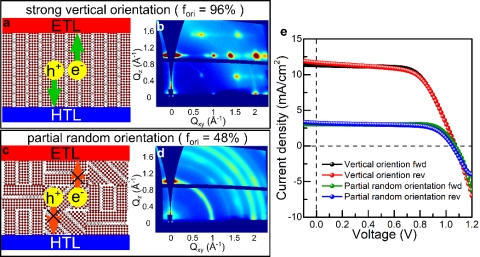MHPs are unique in that they combine low-cost solution processability with superb electronic quality that is comparable to, or surpasses, that of the state-of-the-art epitaxial grown semiconductors. What is particularly exciting about MHPs is that they can be manufactured into lightweight flexible solar cells that can provide power in locations that are difficult for traditional solar cells - drones, cars, soldiers and backpackers.
What did the Scientists Discover?
Two-dimensional (2D) Ruddlesden-Popper MHPs have recently been discovered as very promising materials for both solar cells and LEDs. A key to high device performance is to align the 2D MHP layers, during the solution processing, vertical to the electrodes to achieve efficient charge transport. However, it was not understood how the counter-intuitive vertical orientations of 2D MHPs layers on substrates can be obtained.
In this work, researchers revealed a mechanism responsible for formation of vertically orientated 2D MHPs in thin films using in-situ grazing incidence X-ray scattering. Their results show that heterogeneous nucleation and growth of 2D MHPs occur at the liquid-air interface to form a layer with strong vertical orientation. Knowing the origin of the preferential orientation enabled the researchers to rationally tune the degree of vertical orientation of 2D MHPs. Solar cell performance measurements showed that 2D MHPs with higher degree of vertical orientation result in drastically higher power conversion efficiency than those with more random orientations.
Impact:
This work provides a path to unlock the full potential of 2D MHP optoelectronic devices. This will accelerate the progress toward realizing next generation of solar cells, LEDs and lasers that surpass the performance of state-of-the-art technologies at substantially low-cost.
Collaborators:
Joshua J. Choi, PI, University of Virginia, Department of Chemical Engineering http://faculty.virginia.edu/choi/index.html
Alexander Chen, University of Virginia, Department of Chemical Engineering
Michelle Shiu University of Virginia, Department of Chemical Engineering
Jennifer Ma University of Virginia, Department of Chemical Engineering
Matthew Alpert University of Virginia, Department of Chemical Engineering
Depei Zhang University of Virginia, Department of Physics
Benjamin Foley University of Virginia, Department of Chemical Engineering
Detlef-M. Smilgies, Cornell University, CHESS
Seung-Hun Lee University of Virginia, Department of Physics
Publication citation:
“Origin of vertical orientation in two-dimensional metal halide perovskites and its effect on photovoltaic performance,” Chen AZ, Shiu M., Ma JH, Alpert MR, Zhang D, Foley BJ, Smilgies DM, Lee S-H, Choi JJ, Nature Communications 9:1336(2018), doi:10.1038/s41467-018-03757-0
Funding:
|
Funding Agency |
Grant Number |
|
Early Career Faculty Award Grant from NASA’s Space Technology Research Grants Program |
NNX15AU43G |
|
US Department of Energy Office of Science, Office of Basic Energy Sciences |
DE-SC0016144 |
